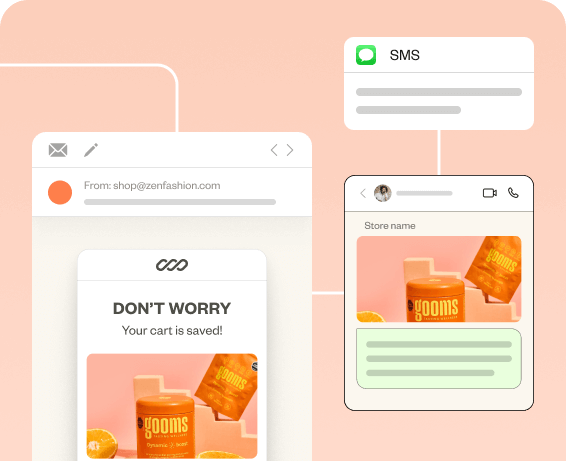Win-back email examples show you how to reconnect with customers who’ve become inactive.
Customers drift off, open rates drop, and sales stall. It’s frustrating, like trying to start a conversation with someone who’s no longer listening.
A great win-back email turns inactivity into engagement, reignites interest, and reminds them why they chose you in the first place.
In this blog, learn all about win-back emails and how to write a high-converting one with our list of 8 best win-back email campaign examples. We have also listed 5 steps to create a successful win-back email campaign.
Let’s dive right in.
Automate your win-back email campaign with Retainful’s easy-to-setup email automation.
What is a Win-Back Email?
Win-back email is a type of email marketing campaign sent to re-engage inactive or lapsed customers and regain their interest in the brand.
The purpose of a win-back email campaign is to “win back” inactive customers by reminding them about your brand, products, or services and encouraging them to make another purchase or become active customers again.
When to Send Win-Back Emails?
When to consider the customer inactive and lapsed and start sending customer win-back email campaigns?
There is no universal definition of customer inactivity, as it can vary based on the business and industry.
Here is when to send win-back emails:
- No purchases for a certain period
- No engagement with emails or marketing communications for an extended time
- No activity or interaction with the brand across any channels for a defined timeframe
A lack of insights into the reasons behind customer churn makes it challenging to address those issues in customer win-back emails.
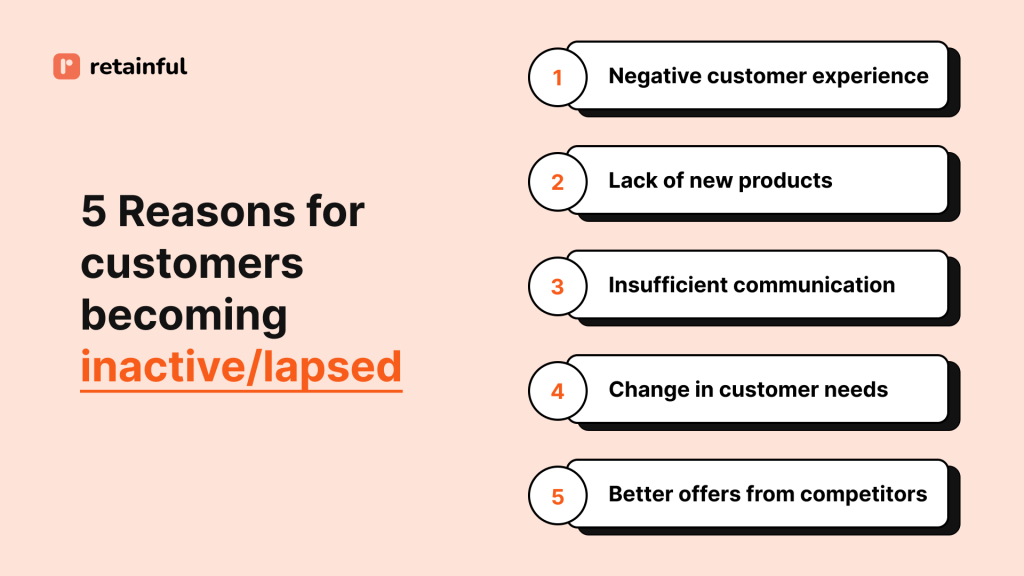
Why Should You Send a Win-Back Email Campaign?
Win-back email campaign is one of the most important campaigns you send as part of your e-commerce email marketing.
Here are the reasons why:
- Success rate: Reactivating just 10% of an email list‘s inactive subscribers can increase revenue by as much as 30%.
- Lapsed customers are not lost, yet: When the customers become inactive, it doesn’t necessarily mean you should consider them a lost cause.
- Customer retention: Sending a win-back email campaign can increase customer retention and lifetime value significantly.
9 Best Win-Back Email Examples
The best win-back email examples are:
- Give new product updates
- Let customers know they had a good time with you.
- Give them a choice – stay or unsubscribe
- Create FOMO
- Make the promise of a better experience
- Address the common customer objections
- Talk about new and improved features
- Give an incentive to re-engage
- Say goodbye
These best customer win-back email examples show you the important elements to include, how to address the objections, and how to write a win-back email that converts more. Let’s pick apart them.
1. Give new products updates
Subject line: Check out what’s new!!

Why is this a good win-back email example?
Most customers lapse when they feel the product or service no longer meets their evolving needs or expectations.
Showing the newly launched products or features like this re-engagement email example will work as a huge green flag and an effective win-back email strategy.
Even if they have lapsed, their pain point remains the same. So, reiterating the benefits of your product reminds customers how you can still help them solve their pain points.
This best customer win-back email example uses concise and straightforward messaging like “We’ve leveled up – Come see what’s new!” to pique the user’s interest and convey the improvements without being too wordy.
2. Let customers know they had a good time with you.
Subject line: You made Duo sad 😢
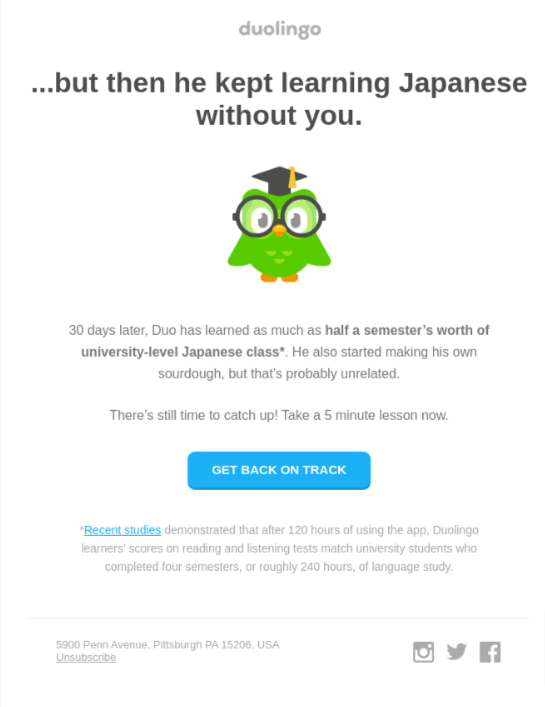
Why is this the best win-back email campaign example?
We all love this best re-engagement email example because it uses a friendly, conversational tone that makes it feel more personalized and engaging rather than a generic mass email.
They have also used subtle proof of how learning with Duolingo is effective.
The CTA “Take a 5-minute lesson now” provides a low-commitment incentive to re-engage with the app.
This personalized win-back email template is a great example of keeping the brand personality intact. Duolingo is known for making the learning experience fun and engaging. This customer win-back email doesn’t fail to reflect the same.
The CTA “GET BACK ON TRACK” button is clear and actionable, making it easy for the user to take the desired step of resuming their language learning.
3. Give them a choice – stay or unsubscribe
Subject line: Pssst…we have a question for you.
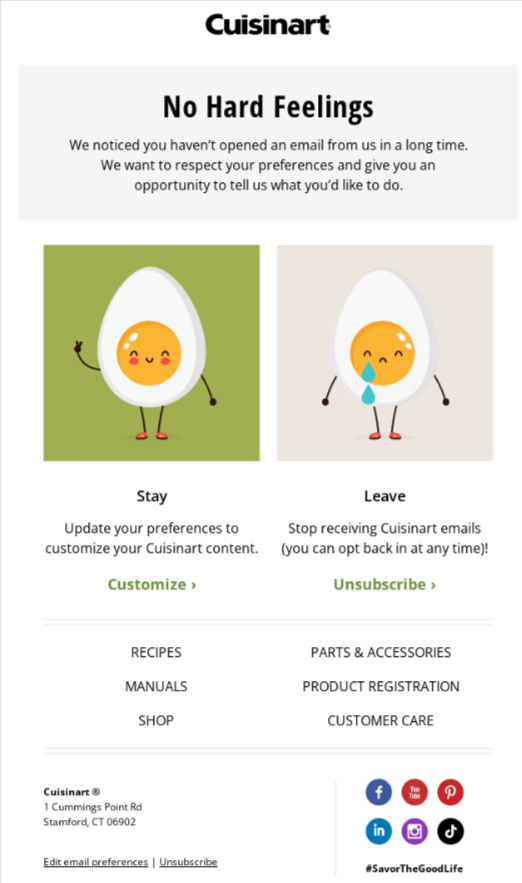
Why is this the best win-back email example?
The cute egg illustrations in this best win-back email example add visual interest, and a touch of brand personality makes this customer win-back email example more engaging and memorable.
The “Customize” and “Unsubscribe” buttons provide straightforward actions for the recipient to take and reduce friction.
By giving the option to unsubscribe without judgment, this great re-engagement email campaign example respects the recipient’s autonomy and avoids being perceived as pushy or intrusive.
4. Create FOMO
Subject line: Check out what’s new!!
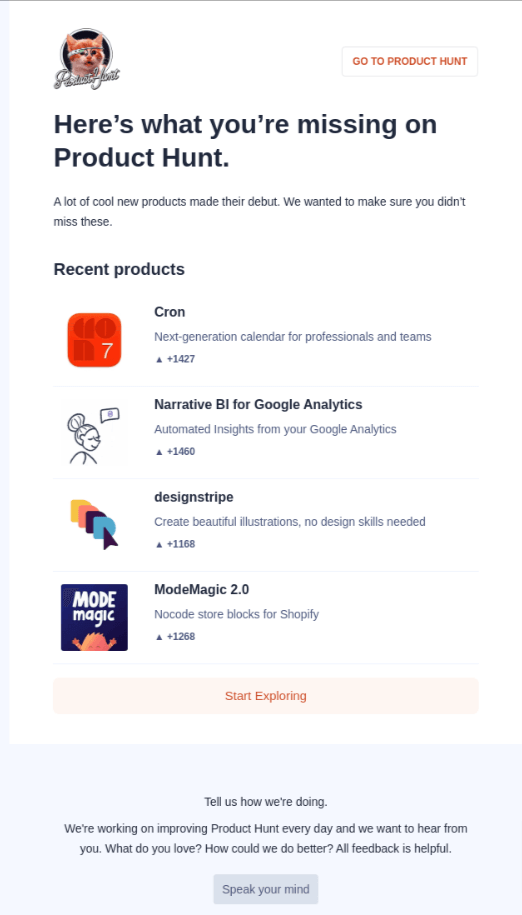
Why is this the best win-back email template?
By showcasing a few specific recent products, this re-engagement email example provides examples of the new content users have been missing out on.
The inclusion of upvote counts (e.g.,+1427) for the featured products adds social proof and reinforces their popularity and relevance.
Asking for feedback in your customer re-engagement campaign signals a commitment to improving your product or service and can change the customer’s mind if they encountered any problems earlier.
5. Make the promise of a better experience
Subject line: Smiles Davis, getting back into Venmo? Here’s a refresher.

Why is this the best customer win-back email example?
Venmo’s best win-back email example brings users who may have been inactive for some time up to speed on the latest developments and makes a strong case that the platform is worth revisiting.
Each new feature is explained concisely yet clearly, highlighting the specific benefits to the user.
Venmo’s customer win-back email campaign example also acknowledges the recipient’s absence with “Since you’ve been gone”. It makes the win-back email copy feel more personalized and relevant.
This personalized win-back email template showcases new, valuable features like cash-back offers and integrated app payments by providing a strong value proposition for users to return to Venmo.
Related Reading: Want to engage your active customers and drive repeat sales? Check out our guide on sending post-purchase emails: 9 Post-Purchase Email Examples that Retain Customers
6. Address the common customer objections
Subject line: Since you have been gone…
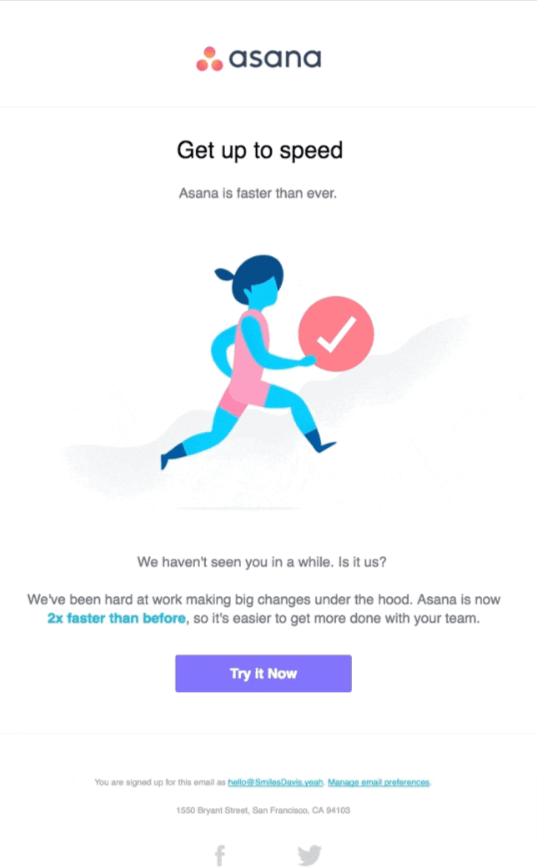
Why is this the best customer win-back email example?
Asana’s best B2B win-back email campaign example directly highlights that Asana is now “2x faster than before,” implying they have improved the performance of their platform, which could have been a pain point causing customers to churn.
By stating they have made major changes, it aims to re-engage those who felt the product was stagnant.
This B2B win-back email copy is concise and gets to the point quickly about the key benefit (faster speed) that Asana hopes will resonate with lapsed users.
This customer win-back email campaign template has a clear call-to-action button, “Try It Now,” that makes it easy for recipients to promptly re-experience the upgraded product.
7. Talk about new and improved features
Subject line: Let’s catch up, Smiles Davis

Why is this the best re-engagement email template?
In this best win-back email example, the headlines “Always new, always improving” and “This is our best AllTrails+ yet” immediately capture attention and convey a message of continuous improvement.
Mentioning the accolade “iPhone App of the Year” adds credibility and reinforces the app’s value.
This customer re-engagement email sample clearly communicates the value of rejoining AllTrails+ by emphasizing the added benefits, such as better planning, never missing a turn, and outdoor experiences.
8. Offer incentives to re-engage
Subject line: Was Avocode too slow for you?

Why is this the best customer win-back email template?
This example of win-back email directly addresses a common pain point, shows that they understand previous user frustrations, and have worked on a solution.
Alo, this B2B sample email to win back old customers is how customer-centric messaging should be. It makes a strong case for the customer to try their product again. Rather than just stating that it is better, it provides more than one reason why it is better.
By suggesting that users give the product another try, this B2B sample email to win back old customers subtly encourages re-engagement without being pushy.
9. Say goodbye
Subject line: We’ll give you 25% off to open this email 🤑
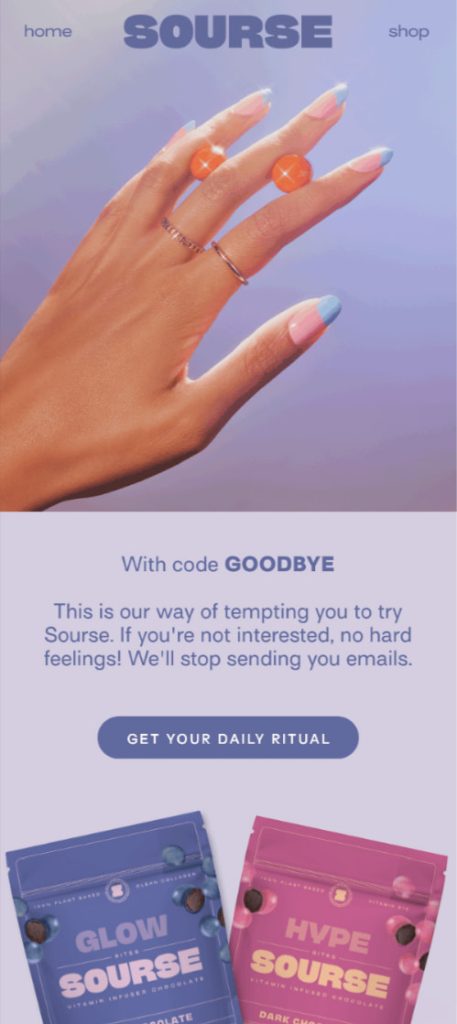
Why is this the best customer win-back email template?
This sunset email campaign example opens with “With code GOODBYE” – a touch of drama, but just enough to make a customer pause. The win-back email copy being the continuation of the subject line is a very clever way to design an email copy.
Also, the CTA is not a typical “Shop now” or”Grab your deal.” It’s “Daily Ritual.” Subtle psychology here – this sunset email example reframes the product as self-care, not just another purchase.
In the last email of the win-back series, mention this is the last email they will receive if they don’t make a purchase and politely sign off.
There you have it. 9 best examples of win-back emails and what makes it high-converting.
Related Reading: Explore more re-engagement email examples and template inspiration in our blog: 8 Great Re-engagement Email Examples to Reactivate Customers
Best Win-Back Email Flow Example
The optimum number of emails to send in a win-back email sequence is 3-5 – from a ‘we miss you’ email, communicating new improvements to offering a compelling offer.
The best win-back email flow example is:
- Email 1 – “We miss you” email (After 45 days of inactivity)
- Email 2 – Highlighting new products or features and offering an incentive ( 3 -7 days after the first email)
- Email 3 – Urgency about the offer + social proof ( 3 -7 days after second email)
- Email 4 – Last chance reminder ( 5 -7 days after third email)
- Email 5 – Goodbye email/ sunset email ( 5 -7 days after fourth email)
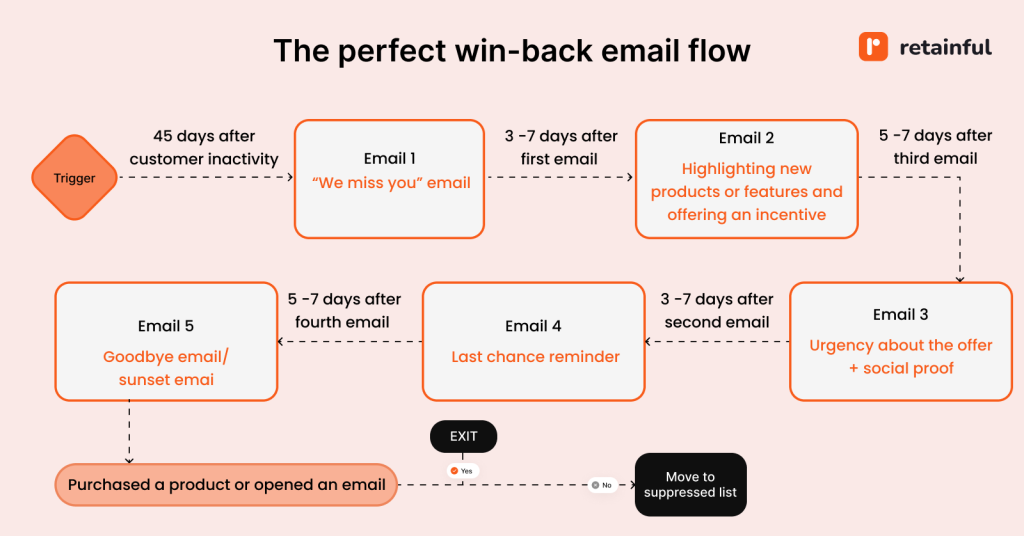
Let’s see what to include in each of these emails in the win-back flow.
Email 1 – “We miss you” email (After 45 days of inactivity)
Begin the first email in the win-back email sequence with a warm, personalized greeting. Use their name and refer the past interactions and purchases.
- Explain that you’ve missed them and are curious if everything is okay.
- Include a brief note about what’s new or what they’ve enjoyed in the past.
- Include a soft CTA to check out your store. Example CTA: “See What’s New” or “Come Say Hi.”
Email 2 – Highlighting new products and offering an incentive ( 3 -7 days after the first email)
Showcase how your brand has evolved and highlight fresh offerings or improvements since their last visit.
- Detail any new product launches, seasonal collections, or upgrades to your services.
- Introduce an incentive early in the email. Example: “Enjoy 15% off your next order as a welcome back gift.”
- Include customer testimonials, reviews, or user-generated content that reinforces trust.
Email 3 – Urgency about the offer ( 3 -7 days after second email)
Present a compelling, exclusive offer that provides a tangible reason to re-engage and make a purchase.
- Clearly state the exclusive discount with urgency (e.g., “Limited time offer. Grab before it expires ”) and steps to redeem it.
- A clear CTA like “Grab the Offer Now” should lead directly to a landing page where the customer can use their offer.
Email 4 – Last chance reminder ( 5 -7 days after third email)
The fourth email in the win-back flow is to reiterate what they’re missing out on if they don’t act now – oot can be the offer or a new product.
- Clearly state that this is the last opportunity to redeem the offer. Subject lines like “Last Chance: Don’t Miss Out!” work well.
- Summarize the key benefits of the offer, new products, or features.
Email 5 – Goodbye email/ sunset email ( 5 -7 days after fourth email)
If the customer hasn’t made a purchase yet, the last email in the win-back email series should be the final one you send to them. After that move the customers into the suppressed list.
- Let the customer know this is the final email they will receive from you, if they don’t engage now.
- You may include a very gentle, “just in case” offer. However, ensure it doesn’t overshadow the farewell tone.
- Reiterate that if they’re no longer interested, they can easily opt-out.
How to Write a Win-Back Email that Makes Customer Purchase Again?
The goal of a win-back email copy is to rekindle interest and get them to make a purchase again.
Here’s a detailed approach to writing successful win-back emails to win back old customers:
1. Personalize your win-back email subject line
The subject line is the first point of contact. Personalizing it based on past interactions is key to getting the email opened.
Use the customer’s name or product they last purchased in the subject line. For example:
- “We Miss You, [Name] – Still Loving [Product]?”
- “It’s Been a While, [Name] – Enjoy 15% Off Your Next Order!”
2. Remind them of the value they’re missing
While writing win-back emails, focus on why they enjoyed buying from you in the first place and the value they’re missing out on. Highlight features like product quality, customer service, and unique selling points (USPs).
- Social Proof: Showcase positive reviews from recent customers to help reignite interest.
- Product Updates: If your product offerings have changed, let them know what’s new or improved.
3. Use urgency & scarcity tactics
To prompt action, include urgency and scarcity. This motivates customers to reactivate before they miss out.
- “Limited time offer – only available for the next 48 hours!”
- “Your favorite items are almost out of stock – don’t wait!”
- Include a countdown timer if possible to add more urgency.
4. Include a clear and compelling Call-to-Action (CTA)
The CTA should be direct and compelling – you want them to take action now. Avoid multiple competing CTAs. Focus on one primary action.
Make the CTA actionable and specific:
- “Claim My 20% Discount”
- “Get Your Free Gift Now”
5. Include a personalized product recommendation
While writing win-back email copy, utilize past purchase data to suggest products the customer is likely to be interested in based on their browsing or purchasing history.
Win-Back Email Best Practices to Increase Reactivation Rate
A win-back email campaign is judged by how many customers it retains and turns into active ones. You can send high-converting win-back customer emails with the help of these best practices.
Here are the best practices for writing win-back emails.
1. Addressing customer objections
Understand why customers have become inactive. Was it due to poor product quality, customer service issues, or better offers from competitors? Address these concerns directly in your win-back messaging.
So, addressing customer objections is the best win-back email strategy to win back old customers and persuade the customers to choose your brand again.
Here are some common customer objections and how to address them in your win-back email campaign:
- Products/services became irrelevant: Highlight newly launched products or features
- Loss of trust: Include trust-building elements like customer testimonials, reviews, guarantees, or certifications.
- Had a bad experience: Offer an apology and show that you’ve improved.
- Found an alternative: Show how your product outperforms the competition. Point out unique benefits, features, or services that other brands don’t offer.
2. Automate win-back emails
Email automation software offers user-friendly win-back email automation workflow and pre-built email templates to launch your reactivation campaign with minimal effort from your end.
Win-back email automation simplifies the process and saves you time and effort compared to manually sending every win-back email.
3. Segment your inactive customers
Not all inactive customers are the same. Some would have been purchasing frequently, and some made a purchase and disappeared. So, you can’t treat all these customers the same and send them a similar re-engagement campaign.
So, the best customer win-back email strategy is to use email segmentation and group your lapsed customers based on their purchase history.
With email marketing tools, you can segment these customers with ease and send personalized win-back customer emails.
The criteria for win-back email segmentation can be:
- Frequent Buyers: Customers who used to purchase frequently but haven’t made a purchase recently.
- One-Time Buyers: Customers who made a single purchase and did not return.
- Who gave negative feedback: Customers who left negative reviews or provided feedback indicating dissatisfaction.
You should focus on different things while targeting these segments in your win-back campaign:
- For frequent buyers: Provide exclusive discounts and early access to new products and acknowledge their value.
- For one-time buyers: Provide a discount and emphasize the benefits of your products.
- For those who gave negative feedback: Start by acknowledging their previous feedback and highlight specific improvements made in response to those.
Here is how to segment customers based on purchase history and identify the best customer segment to re-engage:

4. Send a win-back email flow.
Rather than sending a single email, send a win-back email flow to gradually re-engage customers and increase your chances of winning them back.
A win-back email flow that addresses different pain points over the period is a proven email marketing strategy that you can use for re-engaging campaigns, too.
Here is an example of a win-back series automation workflow.
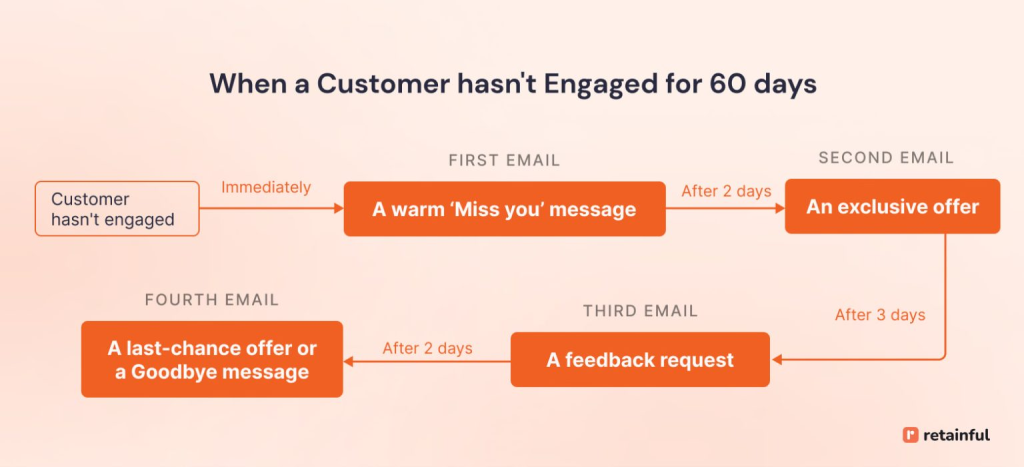
Set up win-back flow in a few clicks with Retainful’s pre-built automation workflows.
5. Tailor your offers based on why they left
Identify the main reasons for churn and offer incentives to address those pain points, expectations, and needs.
For example, if customers leave due to poor service, give a limited free trial of improved support features in your reactivation campaign.
6. Don’t be desperate
Frame your win-back message as a friendly invitation. This helps to build trust and encourages customers to return.
Win-back email vs. sunset flow emails – what is the difference?
You send sunset flow emails after multiple attempts to re-engage with someone had failed, usually after a series of win-back emails. This is for the customers who’ve been completely inactive over a longer period (e.g., 180 days or more) and are unlikely to return.
The sunset flow helps clean your email list, ensuring your email deliverability doesn’t drop because of low engagement or unsubscribes from inactive customers.
Here is how to write a sunset flow email:
Subject Line: “Last chance to stay in the loop”
Body: “We don’t want to bother you, but if you’re still interested, here’s one last chance to stay with us. If not, we’ll say goodbye. But don’t worry, we’ll always be here when you’re ready.”
10 Win-Back Email Subject Lines for High Open Rate
- “Come back and get 20% off your next order!”
- “We Miss You! Here’s 20% to Come Back”
- “Did you forget about us? Your exclusive offer is waiting.”
- “Missed you! We’ve made things better just for you.”
- “We’ve been busy making improvements for you!”
- “We couldn’t forget about you! How about a second chance?”
- “We’re Better Together – Come Back and Save!”
- “We’ve Got a Surprise for You- Come See What’s New!”
- “Here’s 15% Off -Just for You, Because We Miss You!”
- “Remember Us? We’ve Got Something Special Just for You!”
How to Create a Win-Back Email Campaign?
With the best email marketing software that supports email automation, you can create a win-back flow and launch your win-back email campaign in 5 simple steps.
The steps to create a win-back email campaign are:
- Step 1: Choose an email marketing app
- Step 2: Identify inactive customers
- Step 3: Craft the win-back email copy
- Step 4: Setup email automation
- Step 5: Test and optimize
Let’s see these steps in detail.
Step 1: Choose an Email Marketing App
To create a win-back email campaign, select an email marketing app that offers email automation, segmentation, and pre-designed email templates.
Ensure the software integrates with your e-commerce platform.
Step 2: Identify Inactive Customers
Determine what qualifies as an inactive customer (e.g., no purchases or engagement in the last 3, 6, or 12 months).
Step 3: Craft the win-back email copy
Create compelling win-back email subject lines that grab attention.
Use personalization (e.g., the customer’s name and past purchases) to increase the open rates of your win-back email campaign.
Write your emails in an active voice to ensure that the recipient quickly understands your key points. Don’t hold back from paraphrasing text, which can help quickly resurface the message’s clarity and readability.
Here is a sample of the win-back email copy:
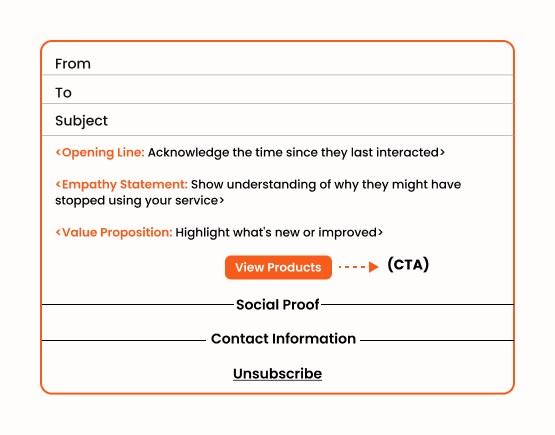
Step 4: Set up email automation
Use email automation to create an automated win-back email workflow in your email marketing app. Schedule the win-back email sequence to be sent over a period at well-timed intervals.
Space out the win-back email flow to avoid overwhelming the customer. For example, send the first email in the win-back series, followed by a reminder after a week, and a final follow-up after another week.

Step 5: Test and optimize
Test different win-back email subject lines, email content, and CTAs to see what resonates best with your audience.
Use the analytics in your email marketing app to track email KPIs like open rates, click-through rates, and conversion rates of your win-back email campaigns.
Launch high-converting win-back email campaigns with Retainful and increase your customer lifetime value.
Wrapping up!!
Win-back emails show your customers that you care, that you’re paying attention, and that their presence matters to you.
Our list of best win-back email examples has shown you how to address your customers’ reasons for lapsing and objections and show them that you care.
Don’t let your lost customers stay lost by creating a successful win-back email campaign using email marketing software like Retainful.
Learn more about how to do successful email marketing:
- 10 Best Email Marketing Examples and Templates
- 10 Best Ecommerce Email Examples + Tips
- Email Marketing Funnel: How to Create + Examples
- Customer Lifecycle Marketing – Strategies for Each Stage + Examples
Frequently Asked Questions
To win back a customer through emails:
– Step 1: Identify why the customer left
– Step 2: Provide a special discount
– Step 3: Highlight new improvements
– Step 4: Send a follow-up email to remind you about the offer
Win-back series tips are:
– Send at well-timed intervals
– Highlight what’s new
– Include social proof
– Reaffirm your value propositions
A win-back email campaign is a series of emails sent to reengage inactive customers, address their objections, and reignite interest in your brand.
The purpose of a win-back email is to re-engage inactive customers, remind them of the value of your product or service, and encourage them to return and make a purchase.
The best win-back email strategies are:
– Send win-back email series
– Use email automation
– Personalize the content based on RFM (Recency, Frequency, Monetary value)
– Address objections in the email
To win-back inactive customers, offer personalized incentives, highlight recent improvements, address potential reasons for inactivity, showcase customer testimonials, and make the re-engagement process easy with clear calls to action.
To create a win-back email flow:
Step 1: Identify inactive customers
Step 2: Craft a series of win-back emails
Step 3: Setup time delay between emails
WinBack refers to efforts to re-engage inactive customers, while churn refers to customers who have completely stopped using a product or service. WinBack aims to prevent churn.
Re-engagement emails involve reactivating any inactive user or customer, while win-back emails specifically target those who have stopped engaging with your product or service entirely, aiming to bring them back.
Key win-back metrics include open rates, click-through rates, conversion rates and reactivation rates.
Win-back automation uses automated email workflows to send timely, personalized messages to inactive customers, aiming to re-engage them.
A sunset flow is a series of emails sent to unengaged subscribers before removing them from your list, aiming to re-engage them one last time before considering them permanently inactive.
Send win-back emails based on customer inactivity duration, typically after 30, 60, and 90 days of inactivity, with follow-up emails.
